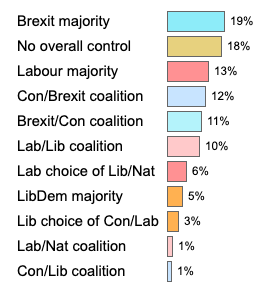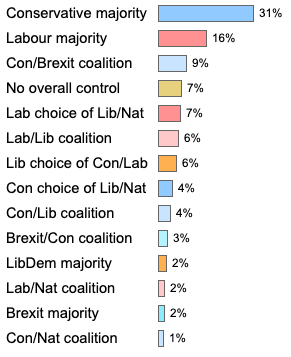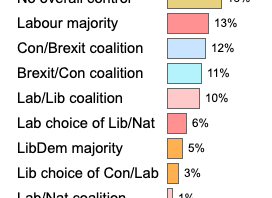- Facebook30
- Threads
- Bluesky
- Total 30
The celestial bodies have aligned to put British politics in that rare situation: a first-past-the-post electoral system with multiple viable parties.
Usually, when a legislature consists of the top vote-getters in all the districts, it evolves (or degenerates?) into a two-party system, because supporters of any other party worry that their votes would be “wasted.” However, due to the turmoil of Brexit, plus the strength of regional parties, several parties will be competitive in the next UK election if it happens soon.
That makes the result extraordinarily difficult to predict. In theory, a party with well under 50% support could come in first in more than half the constituencies and dominate the Commons. You can’t tell how any party will perform just by examining national polls, because it depends on where its votes are concentrated. Britain could have the most socialist government since 1979, the most Thatcherite government since 1990, the first English-nationalist party in its history, or the first Liberal-led parliament since 1922, all depending on the quasi-random question of where the votes lie.
I cannot assess Max Baxter’s Electoral Calculus site, but I don’t see an alternative, and it seems sophisticated. The change that he finds over recent months certainly seems plausible.
In May, many divergent outcomes had fairly similar probabilities. The most likely outcome was a Brexit Party majority, but that was less than a 4-1 bet. The combined odds of either a Labour government or a Labour/Liberal coalition were a bit higher, at 23%.

(“Nat” refers to the Scottish Nationalists plus Plaid Cymru from Wales)
Since then, Brexit voters have shifted to the Tories because Boris Johnson is now the PM. That makes a Conservative government considerably more likely and almost wipes out the chance of a Brexit Party government. (Why vote for them when you can have Boris?) Since the Brexit Party was the most likely to form a government in May, the Tory leadership contest has been very consequential. Here are the current odds, again per Max Baxter:

In national polls, the Tories lead Labour by only about 4-5 percentage points and don’t reach 30% support. But they could still capture a majority of seats in a four-way contest.
I think Boris Johnson faces a bit of a dilemma. If he calls a snap election, he has a 31% chance of being able to govern without any coalition partners, an attractive option considering that 60% of voters are against him. He also has a 52% chance of being able to form some kind of government, with or without partners. To maximize his odds, he must continue to take all the votes away from the Brexit Party, which means a hard-line stance on Europe.
On the other hand, he already leads a government, and if he calls a snap election, he faces about a 48% chance of losing control to the opposition. That makes an election a pretty big risk, a coin-toss. But if he steams ahead with the current parliament, I can only see things getting much, much worse as Brexit hits. A 51% chance of forming a new government now is better than his likely odds any time after October.
On that basis, I think he will call an election and not budge an inch on Brexit until it’s over.
